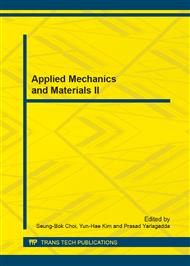[1]
Pierce, L. M., N. C. Jackson, and J. P. Mahoney. Development and Implementation of a Mechanistic, Empirically-Based Overlay Design Procedure for Flexible Pavements[R]. In Transportation Research Record 1388, National Research Council, 1993, pp.120-129.
Google Scholar
[2]
Bayomy, F. M., F. A. Al-Kandari, and R. Smith. Mechanically Based Flexible Overlay Design System for Idaho[R]. In Transportation Research Record 1543, TRB, National Research Council, Washington, D.C., 1996, pp.10-19.
DOI: 10.1177/0361198196154300102
Google Scholar
[3]
J. Garzon, C.A. Duarte† andW. Buttlar. Analysis of Reflective Cracks in Airfield Pavements Using a 3-D Generalized Finite Element Method[R]. Road Materials and Pavement Design. Volume X - n◦ X/2009, pages 1 à 15.
DOI: 10.1080/14680629.2010.9690284
Google Scholar
[4]
1 Rigo, J. M., General Introduction, Main Conclusions of the 1989 Conference on Reflection Cracking in Pavements, and Future Prospects (1993).
Google Scholar
[5]
Gregory S. Cleveland, Joe W. Button and Robert L. Lytton. GEOSYNTHETICS IN FLEXIBLE AND RIGID PAVEMENT OVERLAY SYSTEMS TO REDUCE REFLECTION CRACKING[R]. Report 1777-1, TEXAS TRANSPORTATION INSTITUTE, October (2002).
Google Scholar
[6]
SHAKIR SHATNAWI*, Ph.D., P.E., JORGE PAIS*, Ph.D. and MANUEL MINHOTO**, Ph.D. ASPHALT RUBBER INTERLAYER BENEFITS ON REFLECTIVE CRACK RETARDATION OF FLEXIBLE PAVEMENT OVERLAYS[C]. Proceedings of the 30th Southern African Transport Conference (SATC 2011), 11 - 14 July (2011).
Google Scholar
[7]
Long-term research on key technology of asphalt pavement and demonstration project assessment in Jianghuai region[R]. Jiangsu province expressway management center and Jiangsu Transportation Institute, March (2012).
Google Scholar


